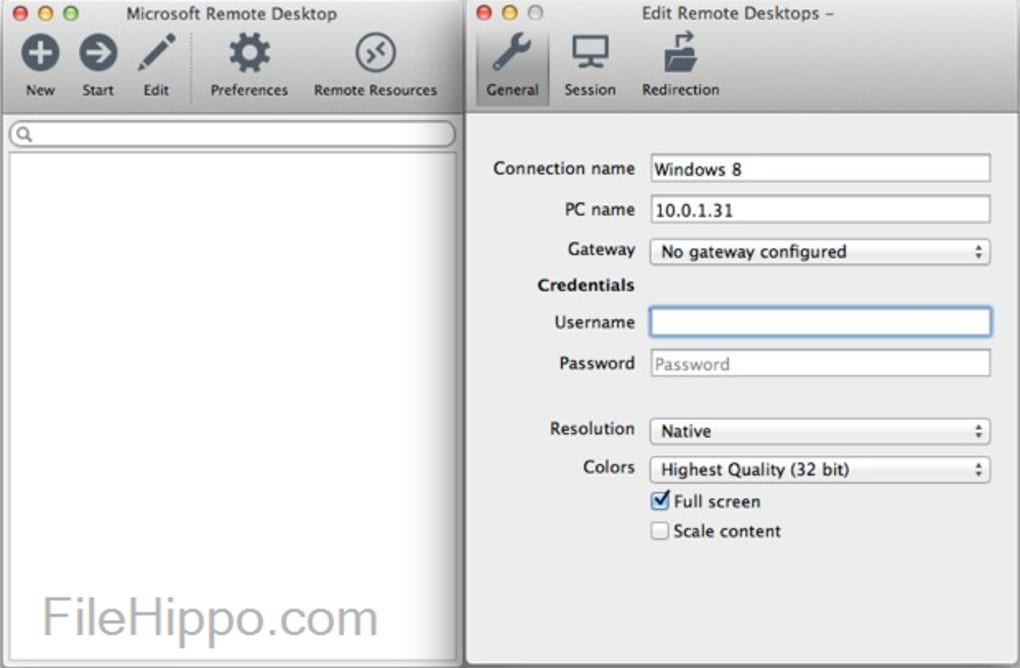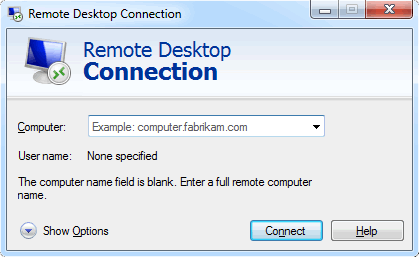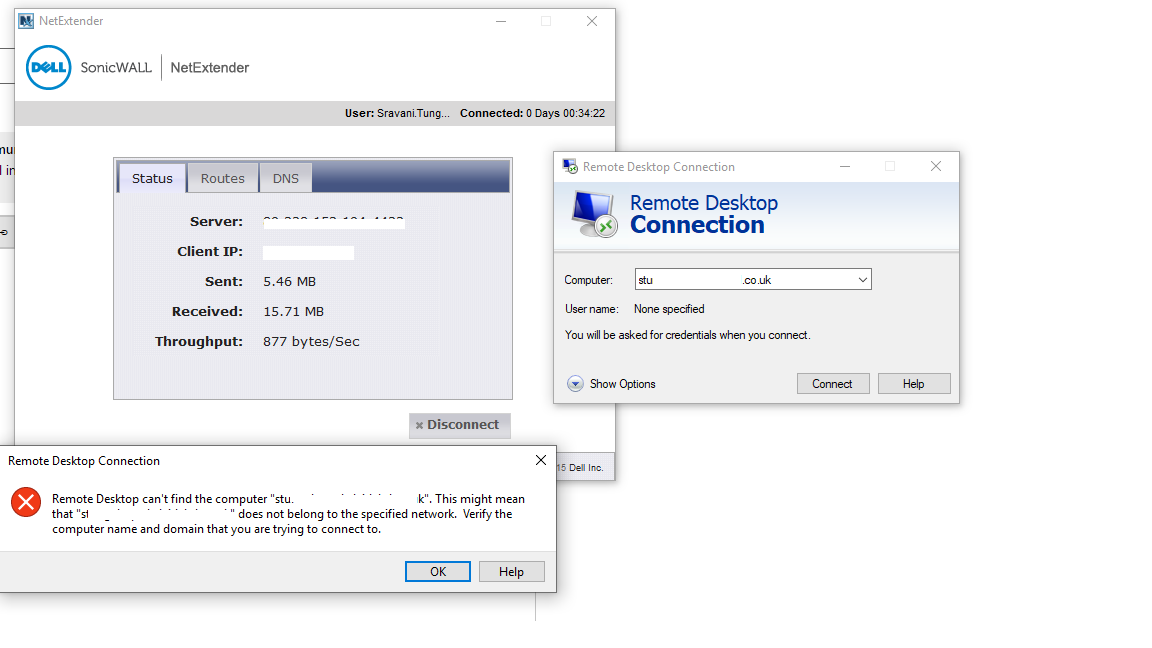Get the Remote Desktop client. Follow these steps to get started with Remote Desktop on your Mac: Download the Microsoft Remote Desktop client from the Mac App Store. Set up your PC to accept remote connections. (If you skip this step, you can't connect to your PC.) Add a Remote Desktop connection or a remote resource. Microsoft's Remote Desktop for Mac has been updated to include native support for Apple silicon. As reported by The 8-Bit: Microsoft yesterday updated its Remote Desktop application to natively support M1 Macs. The updated version will see improved performance and battery efficiency for Mac users with Apple Silicon chips. #Look Microsoft Remote Desktop Connection Client For Mac Vpn Microsoft Remote Desktop Connection Client For Mac Vpn BY Microsoft Remote Desktop Connection Client For Mac Vpn in Articles #Look This is perfect, some rough molding issues and cause offense imperfections here and there but for a clone of a Fab explanation accretion to be this competently made and sturdy for nearly half the price is.
- Microsoft Remote Desktop Mac Vpn Download
- Microsoft Remote Desktop Mac Use Vpn
- Microsoft Remote Desktop Mac Vpn
- Mac Microsoft Remote Desktop Over Vpn
- Microsoft Remote Desktop 10 Mac
- Microsoft Remote Desktop Connection Mac Vpn
- Mac Os Microsoft Remote Desktop
The following instructions will help you to connect to your work machine remotely. In some situations connecting to your machine remotely may not be feasible. It may be better to copy files you may need to a USB flash drive and work on the files locally on your home machine. It is a good idea to encrypt the flash drive especially if you have sensitive files. Here is a page that will help you encrypt the flash drive on windows/mac: https://nordvpn.com/blog/how-to-encrypt-flash-drive/
Another good option, if you will be working remotely for an extended period of time, is to take your machine home. Once connected to the internet at home you should download the VPN to access web-based resources on campus. Please check with your department if they will allow this. You will need to submit an electronic device usage form.
When accessing web-based applications from home please install and use the VPN: https://www.oit.uci.edu/help/vpn/ It is best to use webmail when accessing your email remotely. This will prevent messages from accidently being stored on your home machine while using an email client. If you do use a separate email client, make sure to configure it so your mailboxes, sent folder etc are stored on the server and not locally so you don't have to try to move them later.
Connecting remotely using the operating system's remote desktop capabilities
Mac at work and a PC at home:
* TIP: If you have two displays connected to your work machine consider disconnecting one of the cables from the back of the machine. Also changing the resolution of the display may help if the connection is slow. You might see better performance by following connect remotely with other third party tools below.
1. Turn on Screen Sharing on your work Mac: https://support.apple.com/guide/mac-help/turn-screen-sharing-on-or-off-mh11848/10.15/mac/10.15
2. Install the VPN on the home PC: https://uci.service-now.com/sp?id=kb_article&sys_id=dd09214b0f3331004e32ee68b1050e28
3. Install a VNC client on the your home PC (RealVNC or TightVNC viewer):
Microsoft Remote Desktop Mac Vpn Download
RealVNC: https://www.realvnc.com/en/connect/download/viewer/windows/
TightVNC: https://www.tightvnc.com/download.php
4. On the home PC, start the VPN by connecting to vpn.uci.edu (typically you will only need the UCI profile not the UCIFULL unless accessing library resources): https://uci.service-now.com/kb_view.do?sysparm_article=KB0010199
5. Connect to your work Mac by launching RealVNC or TightVNC Viewer and entering the ip address of your work Mac. Enter your Mac username and password.
6. You should now have access to your Mac's desktop.
Mac at work and a Mac at home:

1. Turn on Screen Sharing on your work Mac: https://support.apple.com/guide/mac-help/turn-screen-sharing-on-or-off-mh11848/10.15/mac/10.15
2. Install the VPN on the home Mac: https://uci.service-now.com/sp?id=kb_article&sys_id=2cf9214b0f3331004e32ee68b1050e36
3. On the home Mac, start the VPN by connecting to vpn.uci.edu (typically you will only need the UCI profile not the UCIFULL unless accessing library resources): https://uci.service-now.com/sp?id=kb_article&sys_id=2cf9214b0f3331004e32ee68b1050e36
4. Connect to your work Mac by entering the ip address of your work Mac (vnc://128.200.x.x), follow the 'Connect using the address' part of this page : https://support.apple.com/guide/mac-help/share-the-screen-of-another-mac-mh14066/mac
5. Enter your Mac username and password.
6. You should now have access to your Mac's desktop.
Microsoft Remote Desktop Mac Use Vpn
PC at work and a Mac at home:
1. Enable Remote Desktop on the work PC: https://docs.microsoft.com/en-us/windows-server/remote/remote-desktop-services/clients/remote-desktop-allow-access
2. Install the VPN on the home Mac: https://uci.service-now.com/sp?id=kb_article&sys_id=2cf9214b0f3331004e32ee68b1050e36
3. Install Microsoft Remote Desktop on the home Mac: https://apps.apple.com/us/app/microsoft-remote-desktop-10/id1295203466?mt=12
4. On the home Mac, start the VPN by connecting to vpn.uci.edu (typically you will only need the UCI profile not the UCIFULL unless accessing library resources): https://uci.service-now.com/sp?id=kb_article&sys_id=2cf9214b0f3331004e32ee68b1050e36
5. Launch Microsoft Remote Desktop on the home Mac and add the work PC by clicking the '+' sign at the top and selecting 'Add PC'. Enter the ip address in the 'PC Name' field and click 'Add'. Then double click the icon for your PC. Log in with your windows username and password.
6. You should now have access to your PC's desktop.
Microsoft Remote Desktop Mac Vpn
PC at work and a PC at home:
1. Enable Remote Desktop on the work PC: https://docs.microsoft.com/en-us/windows-server/remote/remote-desktop-services/clients/remote-desktop-allow-access
2. Install the VPN on the home PC: https://uci.service-now.com/sp?id=kb_article&sys_id=dd09214b0f3331004e32ee68b1050e28
3. On the home PC, start the VPN by connecting to vpn.uci.edu (typically you will only need the UCI profile not the UCIFULL unless accessing library resources): https://uci.service-now.com/kb_view.do?sysparm_article=KB0010199
4. Initiate Remote Desktop connection: https://support.microsoft.com/en-us/help/4028379/windows-10-how-to-use-remote-desktop
5. Type in the ip address of the work PC and click connect. Log in with your windows username and password.
6. You should now have access to your PC's desktop.
Linux at work or home
Installing the vpn: https://uci.service-now.com/sp?id=kb_article&sys_id=1c1be14b0f3331004e32ee68b1050e49
If you need assistance accessing a linux based system, please contact us pscsg@ps.uci.edu
Connecting remotely with other third party tools
Another tool you can try to use is the Chrome Remote Desktop Extension. You can install this extension in the google chrome browser on your work computer and your home computer to access your machine remotely: https://remotedesktop.google.com/home This solution doesn't require you to connect to the VPN but does require a google account.
Those with issues, can they ping (fqdn / ip) and resolve the server ok? Do they have a valid IP, Gateway and DNS address?
Mac Microsoft Remote Desktop Over Vpn
What happens when you actually try to connect, let's say with cord?
Microsoft Remote Desktop 10 Mac


Can you telnet to the server on port 3389 ?
There should be no need to install a cert, it might prompt you to 'accept' or 'verify' the server and that should be it.
Microsoft Remote Desktop Connection Mac Vpn

Mac Os Microsoft Remote Desktop
Can they connect ok when they are on the same network?
Have you tried to give the MAC a different IP so you know it's not a conflict?+
You might have routing issues with them being in the same subnet...
